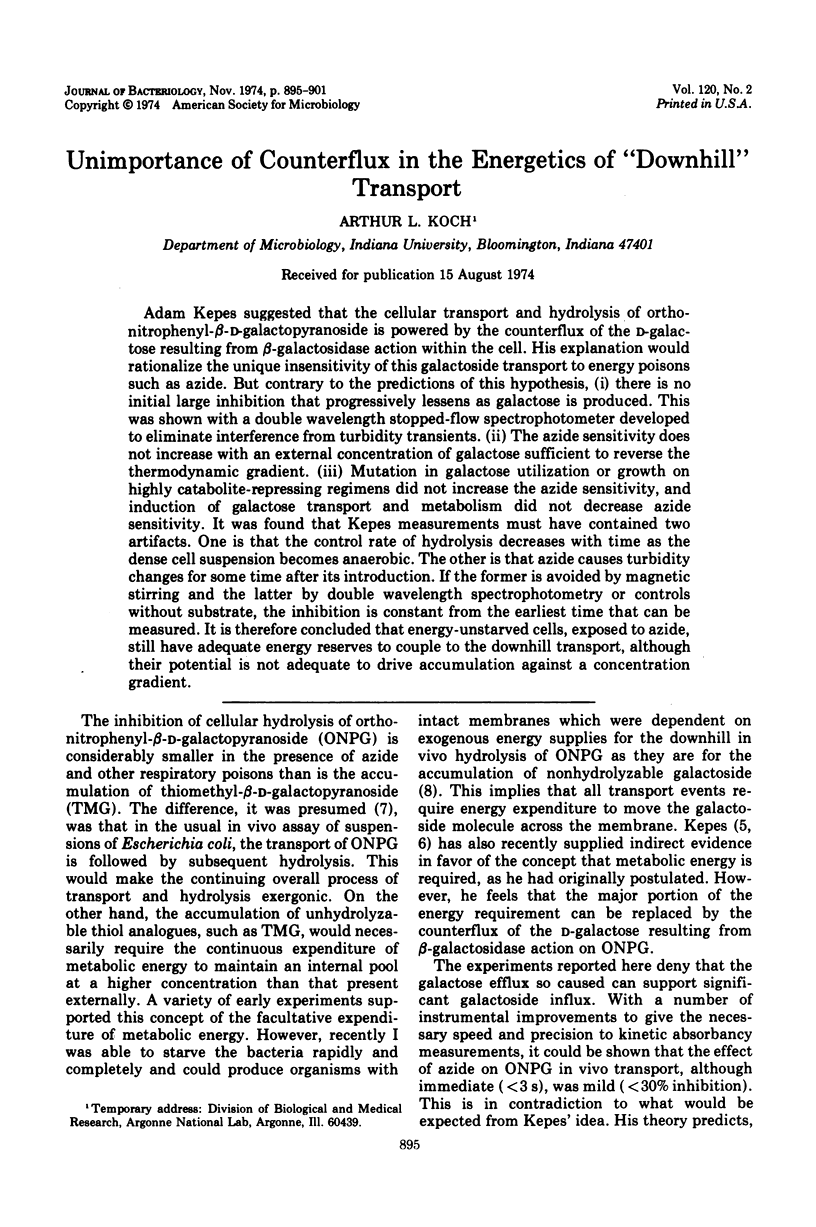Abstract
Adam Kepes suggested that the cellular transport and hydrolysis of orthonitrophenyl-β-d-galactopyranoside is powered by the counterflux of the d-galactose resulting from β-galactosidase action within the cell. His explanation would rationalize the unique insensitivity of this galactoside transport to energy poisons such as azide. But contrary to the predictions of this hypothesis, (i) there is no initial large inhibition that progressively lessens as galactose is produced. This was shown with a double wavelength stopped-flow spectrophotometer developed to eliminate interference from turbidity transients. (ii) The azide sensitivity does not increase with an external concentration of galactose sufficient to reverse the thermodynamic gradient. (iii) Mutation in galactose utilization or growth on highly catabolite-repressing regimens did not increase the azide sensitivity, and induction of galactose transport and metabolism did not decrease azide sensitivity. It was found that Kepes measurements must have contained two artifacts. One is that the control rate of hydrolysis decreases with time as the dense cell suspension becomes anaerobic. The other is that azide causes turbidity changes for some time after its introduction. If the former is avoided by magnetic stirring and the latter by double wavelength spectrophotometry or controls without substrate, the inhibition is constant from the earliest time that can be measured. It is therefore concluded that energy-unstarved cells, exposed to azide, still have adequate energy reserves to couple to the downhill transport, although their potential is not adequate to drive accumulation against a concentration gradient.
Full text
PDF






Selected References
These references are in PubMed. This may not be the complete list of references from this article.
- Coffman R. L., Norris T. E., Koch A. L. Chain elongation rate of messenger and polypeptides in slowly growing Escherichia coli. J Mol Biol. 1971 Aug 28;60(1):1–19. doi: 10.1016/0022-2836(71)90442-6. [DOI] [PubMed] [Google Scholar]
- Ganesan A. K., Rotman B. Transport systems for galactose and galactosides in Escherichia coli. I. Genetic determination and regulation of the methyl-galactoside permease. J Mol Biol. 1966 Mar;16(1):42–50. doi: 10.1016/s0022-2836(66)80261-9. [DOI] [PubMed] [Google Scholar]
- Hsie A. W., Rickenberg H. V. Catabolite repression in Escherichia coli: the role of glucose 6-phosphate. Biochem Biophys Res Commun. 1967 Nov 17;29(3):303–310. doi: 10.1016/0006-291x(67)90453-6. [DOI] [PubMed] [Google Scholar]
- KOCH A. L. THE ROLE OF PERMEASE IN TRANSPORT. Biochim Biophys Acta. 1964 Jan 27;79:177–200. doi: 10.1016/0926-6577(64)90050-6. [DOI] [PubMed] [Google Scholar]
- Koch A. L., Coffman R. Diffusion, permeation, or enzyme limitation: a probe for the kinetics of enzyme induction. Biotechnol Bioeng. 1970 Sep;12(5):651–677. doi: 10.1002/bit.260120503. [DOI] [PubMed] [Google Scholar]
- Koch A. L. Energy expenditure is obligatory for the downhill transport of galactosides. J Mol Biol. 1971 Aug 14;59(3):447–459. doi: 10.1016/0022-2836(71)90309-3. [DOI] [PubMed] [Google Scholar]
- Koch A. L. Local and non-local interactions of fluxes mediated by the glucose and galactoside permeases of Escherichia coli. Biochim Biophys Acta. 1971 Oct 12;249(1):197–215. doi: 10.1016/0005-2736(71)90097-6. [DOI] [PubMed] [Google Scholar]
- Koch A. L. The adaptive responses of Escherichia coli to a feast and famine existence. Adv Microb Physiol. 1971;6:147–217. doi: 10.1016/s0065-2911(08)60069-7. [DOI] [PubMed] [Google Scholar]
- ROTMAN B., GUZMAN R. Transport of galactose from the inside to the outside of Escherichia coli. Pathol Biol. 1961 Apr;9:806–810. [PubMed] [Google Scholar]
- Rotman B., Ganesan A. K., Guzman R. Transport systems for galactose and galactosides in Escherichia coli. II. Substrate and inducer specificities. J Mol Biol. 1968 Sep 14;36(2):247–260. doi: 10.1016/0022-2836(68)90379-3. [DOI] [PubMed] [Google Scholar]
- Stubbs J., Horwitz A., Moses V. Studies on beta-galactoside transport in a Proteus mirabilis merodiploid carrying an Escherichia coli lactose operon. J Bacteriol. 1973 Oct;116(1):131–140. doi: 10.1128/jb.116.1.131-140.1973. [DOI] [PMC free article] [PubMed] [Google Scholar]
- Winkler H. H., Wilson T. H. The role of energy coupling in the transport of beta-galactosides by Escherichia coli. J Biol Chem. 1966 May 25;241(10):2200–2211. [PubMed] [Google Scholar]


